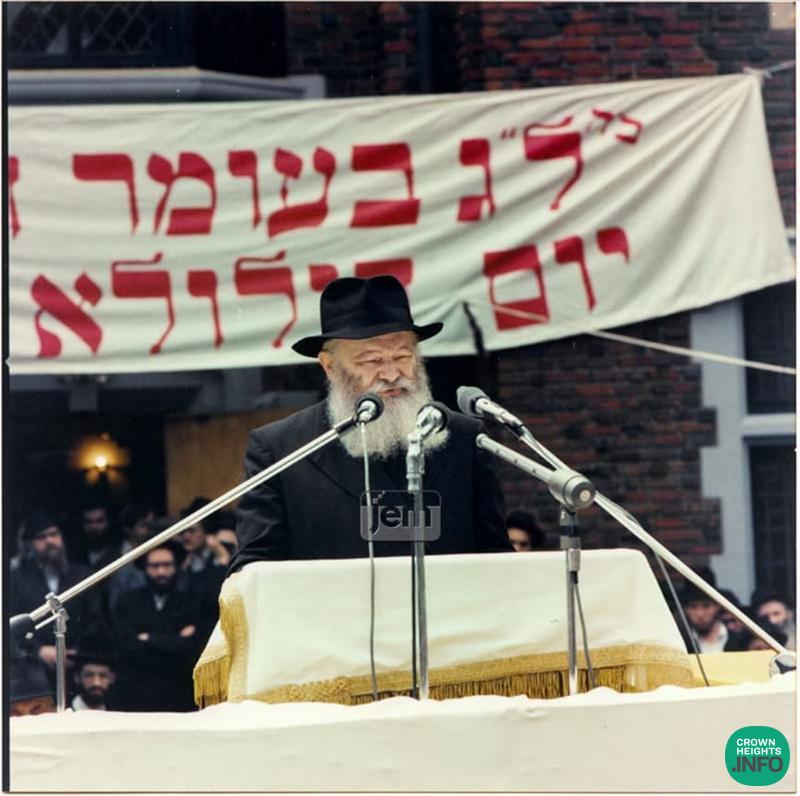
Weekly Dvar Torah: A Child’s Memory and The Rebbe’s Weapons
It was Lag BaOmer, the 18th of Iyar, 5727 — May 28, 1967. I was just a child, standing among thousands of Jewish boys and girls gathered in front of 770 Eastern Parkway, listening intently to the words of the Rebbe at the annual Lag BaOmer parade.
Only eight days later, the Six-Day War would erupt in Israel — a war that survivors of WWII feared might become a second Holocaust. The Jewish world was trembling. In Israel, over 100,000 graves had been sanctified in anticipation of massive casualties. Foreign embassies were urging their citizens to evacuate. Even in Brooklyn, the panic was palpable. The trauma of the Holocaust was barely two decades old. The Jewish people stood at the edge of dread and uncertainty.
But then came the Rebbe. A singular voice. Calm. Confident. Radiant with Emunah.
I remember it so clearly, as if I’m still that child standing there. The Rebbe turned to us — children! — and declared:
“Your brothers and sisters in the Holy Land find themselves in a special situation where G-d is sending them all His blessings and protection in a much greater way, so that they will come out from this crisis with much success.
“You boys and girls are obligated to do all that you can to help them — by adding in Mitzvos, performing more good deeds, and influencing others to do the same. In this merit, G-d will fulfill His promise (as read in this week’s Parsha): ‘You will dwell securely in your land, and I will place peace upon the land… I will be your G-d, and you will be My people.’”
The Rebbe’s words weren’t cautious hope or desperate prayer — they were certainty. He was already promising victory. Before the war even began!
That same week, the Rebbe launched what would become one of the most iconic mitzvah campaigns of our time: Mivtza Tefillin, the Tefillin campaign. Quoting the Talmudic teaching that when a Jew wears Tefillin, G-d’s name rests visibly upon him — and the nations of the world fear him — the Rebbe called upon Jews around the world to help their brothers by encouraging them, especially Israeli soldiers, to put on Tefillin.
“וראו כל עמי הארץ כי שם ה׳ נקרא עליך ויראו ממך — אלו תפילין שבראש ר’ אליעזר הגדול אומר אלו תפילין שבראש.” “And all the nations of the world shall see that the name of G-d is upon you, and they shall fear you — says Rabi Eliezer the great one, this refers to the Tefillin as they are placed on the head.” (Brachot 6a).
This was no abstract hope. It was strategy — spiritual strategy, prophetic in its clarity and success. And the rest, as they say, is history.
The war began on June 5. Israel stood utterly alone — a tiny nation of fewer than two million Jews, surrounded by hundreds of millions of Arabs from 22 countries shouting, “Throw them into the sea.” Not one nation, not even the United States or any Western power, came to Israel’s aid.
But G-d had different plans.
In six miraculous days, Israel trounced the Arab armies, liberated Yerushalayim and the Kosel, and restored Jewish pride and faith across the globe. The impossible had happened — in plain sight.
Jews around the world cried tears of gratitude and danced with overflowing joy. They saw the clear hand of Hashem — and they responded with renewed faith, many answering the Rebbe’s call to don Tefillin. At the newly freed Western Wall, over one million Jews wrapped Tefillin in the weeks that followed. It was a sight unseen in generations. Hundreds of thousands more joined across the globe.
I remember how the euphoria swept through the Jewish people. After centuries of persecution, fear, and exile — we stood tall again.
There was a story that circulated among IDF soldiers and made its way to the media — including Life Magazine’s photo issue on the war. The desert battlefield was littered with abandoned Arab boots. The enemy soldiers had literally run for their lives — barefoot. Military reports revealed that Arab troops had fled so fast they couldn’t manage with their combat boots, so they tore them off and bolted.
Why?
When Israeli forces interrogated captured soldiers, the POWs described what they saw through their binoculars: Jewish soldiers putting on strange black boxes on their heads, and wrapping black straps around their arms.
“We always heard that the Jews had some dangerous, mysterious weapon,” one prisoner explained. “We couldn’t figure out what those black things were. We searched our military intelligence databases and found nothing. Whatever it was — we knew we couldn’t fight it. So we ran.”
The “weapon” they feared was Tefillin.
A piece of leather. A scroll of Torah. A Jew’s commitment. And the nations fled.
It’s been almost six decades since that Lag BaOmer in Crown Heights. But the Rebbe’s voice still rings in my ears, stronger than ever. His message is no less relevant today than it was then.
He didn’t just teach us how to hope. He showed us how to act — how to bring blessing into this world through faith and Mitzvos. He gave us tools. He gave us confidence. He gave us a mission.
So as we anguish over current events in Israel and we hear shouting of “from the river to the sea,” we respond by putting on Tefillin. As we remember the miracles of the Six-Day War and the Rebbe’s fearless promise of victory, let us rededicate ourselves to that mission. Let’s put on Tefillin with more energy and joy — and help our fellow Jew do the same. Let us remember: we are not alone. We never were.
The Rebbe reassured us then. And his message continues to reassure us now. Because when we step forward with faith, Hashem steps in with miracles.
Have G-d’s Name Placed on You and Be Fearless,
Gut Shabbos,
Rabbi Yosef Katzman














